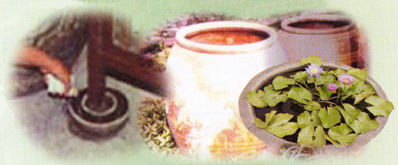Dengue Hemorrhagic Fever
Compiled By : Assoc.Prof. Chukiat Sirivichayakul
Assist.Prof. Achara Asavanich
Ms. Vipa Prariyanuphan
Produced By : Information leaflet committee, Faculty of Tropical Medicine,
Mahidol University and Department of Disease Control, Ministry
of Public Health
.jpg)
The causative agent of denfue hemorrhagic fever (DHF) is dengue virus, of which there are 4 serotypes. When a person is infected with dengue virus for the first time, clinical signs and symptoms are usually mild. However, if he/she is reinfected with a different type of dengue virus, severe conditions such as bleeding or shock will occur and can be fatal. This disease is usually found in children less than 15 years of age.
Aedes aegypti is the main mosquito vector that transmits the dengue virus from person to person. When a female A. aegypti feeds on a dengue virus infected person, the viruses multiply in the insect body and remain there for the whole life span of the mosquito, approximately 1-2 months. Viruses are then transferred to another person being bitten by an infected mosquito.
A. aegypti can be found both inside and outside houses. They prefer to feed during the day. Their breeding places are containers with clear water, for example, jars, vases, ant traps, dishes, cans, pots, flower pots, tires, etc. The prevalence of DHF increases in the rainy season when the mosquito vectors are abundant and children often stay indoors during the day. However, in big cities such as Bangkok, this disease occurs sporadically all year round.
Approximately 80-90% of persons infected with dengue virus for the first time are asymptomatic. Hign fever, headache, muscle and joint pain, and minute bleeding spots under skin may be found in some cases. A second infection with a different type of dengue virus, however, causes more severe conditions, which can be divided into 3 phases :
.jpg)
Standard criteria of the World Health Organization for the diagnosis of DHF are high fever, easy bleeding (positive tourniquet test, bruises, nose-bleed, gum bleeding, etc.), abdominal pain at the right costal margin because of the enlargement of the liver, shock, decreased platelets, and hemoconcentration. Serological and/or virological investigations may be performed to confirm the diagnosis
.jpg)
There is no specific antiviral treatment. Symptomatic and supportive measures are most important. To lower the temperature during the febrile phase, acetaminophen should be given. Aspirin must not be used since it is known to cause bleeding. An antiemetic can also be given to prevent nausea and vomiting. Juice or oral rehydration solution in small amounts given frequently are helpful. Close observation for early signs of shock is necessary. The critical period is at the transition from the febrile to the afebrile phase. Parents should be advised about the warning signs of shock, such as, reduced urination, restlessness or drowsiness, coldness of extremities, or fainting. If these symptoms occur, the patient should be hospitalized immediately.
Prevention
The goal for the prevention and control of DHF is the control of mosquito vectors by several means, such as :
1.Preventing children/adults from being bitten by a mosquito vector; using a bed-net, even during the day, is advisable.
2.Eliminating breeding places of mosquito vectors inside and around houses
- changing water in containers, such as flower vases, every week
- getting rid of unused, broken objects, such as old tires, flower pots
- putting guppies or other fish that feed on mosquito larvae into lotus
ponds or other water sources
- all water containers should be covered; the use of larvicidal sand
granules (temephos) in water storage tanks to destroy the
mosquito larvae is advisable
- mixing salt or vinegar with water in ant traps










